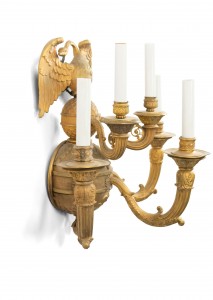X
{{ modalTitle }}
PLEASE FILL IN THE REQUIRED FIELDS.X
X
{{ modalTitle }}
Choose one of the options below.X
ITEM SUCCESSFULLY
ADDED TO PROJECT
Pair of French Empire Bronze Wall Sconces
 French
French Empire
Empire Lighting
Lighting Sconce
Sconce
Newel Warehouse
32-00 Skillman Ave
Long Island City NY - 11101
 (212) 758-1970
(212) 758-1970
Pair of French Empire Bronze Wall Sconces

Newel Warehouse
32-00 Skillman Ave
Long Island City NY - 11101
 (212) 758-1970
(212) 758-1970
 Lighting
Lighting Sconce
SconceEmpire
A period of design during the reign of Napoleon I. It was most prevalent between 1800 and the late 1820s. It was considered the second wave of neoclassicism and marked a return to ostentatious design, a departure from the more conservative Directoire period that directly preceded it. It was intended to idealize the majesty of the French state and Napoleonic rule. Mahogany was the most popular wood during the period, and brass ornamentation and dark marbles were in vogue. Greek, Roman, and Egyptian motifs were also widely used. The style spread throughout Europe and appeared in America in some of Duncan Phyfe's work.
Sconce
A wall-mounted bracket light, typically with an upward-facing arm that holds, in antique sconces, an oil lamp or candle, or in modern examples, an electrified light. Antique sconces were used often in corridors or in pairs on both sides of an entryway. They featured a reflective backplate to intensify candlelight while keeping the candle a safe distance from the wall. They are commonly made of metals such as silver, bronze, or ormolu and became very decorative in the 18th Century.
Empire
A period of design during the reign of Napoleon I. It was most prevalent between 1800 and the late 1820s. It was considered the second wave of neoclassicism and marked a return to ostentatious design, a departure from the more conservative Directoire period that directly preceded it. It was intended to idealize the majesty of the French state and Napoleonic rule. Mahogany was the most popular wood during the period, and brass ornamentation and dark marbles were in vogue. Greek, Roman, and Egyptian motifs were also widely used. The style spread throughout Europe and appeared in America in some of Duncan Phyfe's work.
Sconce
A wall-mounted bracket light, typically with an upward-facing arm that holds, in antique sconces, an oil lamp or candle, or in modern examples, an electrified light. Antique sconces were used often in corridors or in pairs on both sides of an entryway. They featured a reflective backplate to intensify candlelight while keeping the candle a safe distance from the wall. They are commonly made of metals such as silver, bronze, or ormolu and became very decorative in the 18th Century.
Empire
A period of design during the reign of Napoleon I. It was most prevalent between 1800 and the late 1820s. It was considered the second wave of neoclassicism and marked a return to ostentatious design, a departure from the more conservative Directoire period that directly preceded it. It was intended to idealize the majesty of the French state and Napoleonic rule. Mahogany was the most popular wood during the period, and brass ornamentation and dark marbles were in vogue. Greek, Roman, and Egyptian motifs were also widely used. The style spread throughout Europe and appeared in America in some of Duncan Phyfe's work.
Sconce
A wall-mounted bracket light, typically with an upward-facing arm that holds, in antique sconces, an oil lamp or candle, or in modern examples, an electrified light. Antique sconces were used often in corridors or in pairs on both sides of an entryway. They featured a reflective backplate to intensify candlelight while keeping the candle a safe distance from the wall. They are commonly made of metals such as silver, bronze, or ormolu and became very decorative in the 18th Century.













